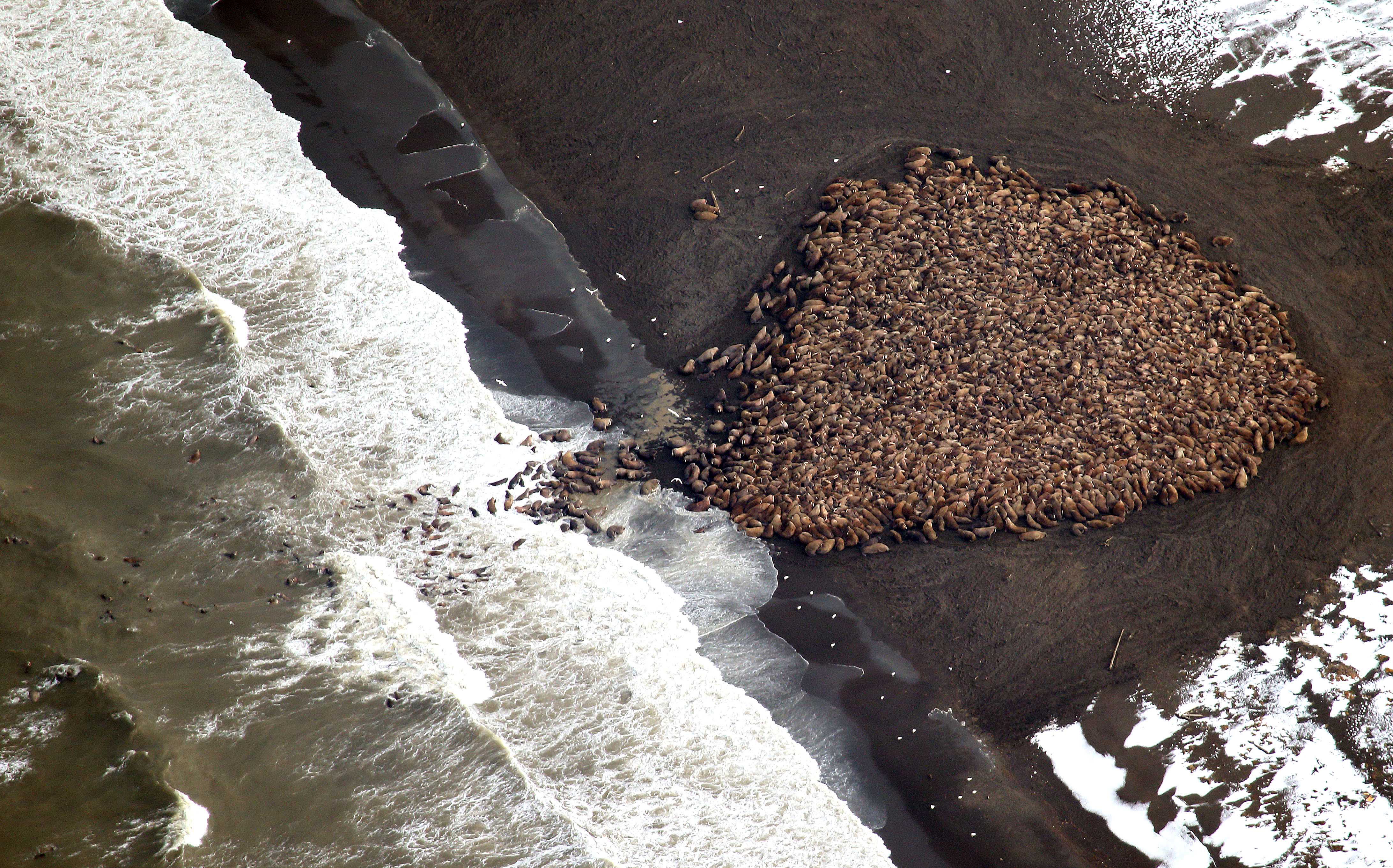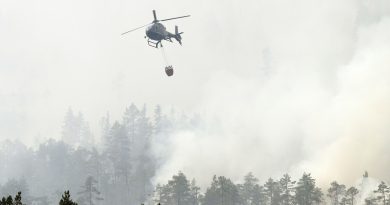Huge onshore crowds of walruses a new phenomenon for Arctic Alaska, scientists say

Gatherings of thousands of walruses crowded together on northwestern Alaska shorelines, like the congregation of 35,000 animals spotted this weekend near the Inupiat Eskimo village of Point Lay, have become regular occurrences in the new era of scarce summer sea ice.
But the behavior is different from what walruses did in the past, and possibly costly to the big marine mammals, scientists from three federal agencies said at a telephone briefing on Wednesday.
“This pattern of coastal haulouts is a relatively new phenomenon in our lifetime,” Chadwick Jay, a research ecologist who heads the U.S. Geological Survey’s walrus program, said in the briefing.
In the past, walruses were able to find enough floating sea ice off Arctic Alaska’s coast, even at the end of the seasonal melt, to stay far offshore and make quick trips to the seafloor for clams, snails, worms and other food, said Jay and Joel Garlich-Miller, a biologist with the U.S. Fish and Wildlife Service.
Walruses’ preferred foraging grounds are out over the broad continental shelf, where waters are shallow, prey is plentiful and — in past years — ice floes available all summer and fall to serve as convenient sites to rest and nurture calves in between food-hunting swims, the scientists said.
Changes in 2007
That changed in 2007, which was, at the time, a record-low year for Arctic sea ice cover, they said. Almost every year since then, walruses have gathered onshore in northwestern Alaska, in crowds “largely made up of animals that have run out of sea ice and have no place to go,” Jay said.
Swimming to shore at places like Point Lay, a site about 700 miles northwest of Anchorage, gives the walruses a place to rest, but “it comes at a cost,” he said. “There may be some small pockets of food, but it seems to be rather sparse,” he said. The best food supplies are far away from shore, he said, at a shallow area known as the Hanna Shoal, a swim of 120 to 150 miles from Point Lay.
Compared to foraging trips from ice that take just a couple of days, Jay said, walruses stopping at onshore haulouts have have to spend up to two weeks swimming, without rest, to forage for food — meaning more energy spent and less opportunity to recover from the effort.
Large crowds of walruses jammed on shores mean other troubles. Individual walruses are at risk of being trampled to death if stampedes occur, the scientists said. Especially at risk are small, juvenile walruses, they said.
Point Lay
The walrus congregation near Point Lay was spotted and photographed by biologists conducting monitoring flights organized by the National Oceanic and Atmospheric Administration and the U.S. Bureau of Ocean Energy Management. The NOAA- and BOEM-sponsored flights are being used by a variety of agencies to monitor marine mammals in Arctic waters off Alaska, including waters where BOEM has sold leases to energy companies hoping to drill oil wells.
The biologists on those flights are studying other animals as well, said Megan Ferguson of NOAA, chief scientist for the Aerial Surveys of Arctic Marine Mammals program.
They noticed several brown bears in the area being used by the walruses, she said. “The number of brown bears that we’ve seen is more than we’ve seen in the previous surveys that I’ve been involved with,” she said.
Biologists first spotted the crowd of walruses on Sept. 13, when about 10,000 of the animals were packed on the shore, Ferguson said. Ten days later, the group was far smaller, with only about 1,500 at the site. But on Saturday, the walrus crowd had swelled to a size that biologists estimated at 35,000.
Danger of disturbances
Those figures are broad estimates, and show how onshore walrus groups wax and wane as hungry animals come ashore and go back to sea, Garlich-Miller said. “Typically, what we see at a lot of walrus haulout sites is the numbers fluctuate greatly,” he said.
As at other times when large numbers of walruses are gathered onshore and vulnerable to disturbances that might trigger a deadly stampede, agencies have established some guidelines for temporary protections. The Federal Aviation Administration and local authorities are advising pilots, boaters and hunters to stay away, said Garlich-Miller. Fixed-wing aircraft should be at least 2,000 feet above and half a mile to the side of the walrus site, while noisier helicopters should stay 3,000 feet above and a mile away, he said. “The government and the local community (are) respectfully asking people to leave the haulout alone to minimize disturbances,” he said.
Arctic sea ice reached a record low level in 2012, the lowest coverage recorded since satellite measurements began in 1979, according to the National Snow and Ice Data Center in Boulder, Colorado.
The USGS walrus research program is part of the agency’s Changing Arctic Ecosystems Initiative, which is also evaluating impacts of sea-ice loss on polar bears.
Related stories from around the North:
Canada: Nunavut hunters seeing fewer ringed seals in Canada’s eastern Arctic, CBC News
Finland: Building dens for Finland’s Saimaa seals, Yle News
Iceland: Endangered whale meat shipped from Iceland via Halifax, The Canadian Press
Sweden: Rare dolphin spotted on Sweden’s west coast, Radio Sweden
United States: Biologists spot huge gathering of walruses in Arctic Alaska, Alaska Dispatch



